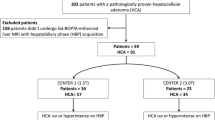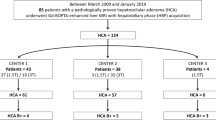Abstract
Purpose
The purpose of our study was to correlate the quantitative analysis of benign hepatocellular tumor uptake on delayed hepatobiliary phase (HBP) imaging with the quantitative level of OATP expression.
Methods
This single-center retrospective study, which took place between September 2009 and March 2015, included 20 consecutive patients with a proven pathologic and immunohistochemical (IHC) diagnosis of FNH or HCA, including quantification of the OATP expression. The patients underwent Gd-BOPTA-enhancement MRI, including an HBP. The analysis of HBP uptake was performed using the liver-to-lesion contrast enhancement ratio (LLCER). Mean LLCER and OATP expressions were compared between FNH and HCA, and the expression of OATP was correlated with the LLCER value.
Results
Of the 23 benign hepatocellular tumors, 9 (39%) were FNH and 14 (61%) were HCA, including 6 inflammatory, 2 HNF1a inactivated, 3 β-catenin-mutated and 3 unclassified HCAs. On HBP, 100% of the FNH appeared hyper- or isointense, and 79% of the adenomas appeared hypointense. The mean OATP expression of FNH (46.67 ± 26.58%) was significantly higher than that of HCA (22.14 ± 30.74%) (p = 0.0273), and the mean LLCER of FNH (10.66 ± 7.403%) was significantly higher than that of HCA (-13.5 ± 12.25%) (p < 0.0001). The mean LLCER of β-catenin-mutated HCA was significantly higher than that of other HCAs (p = 0.011). Significant correlation was found between the OATP expression and LLCER values (r = 0.661; p = 0.001).
Conclusion
In benign hepatocellular tumors, the quantitative analysis of hepatobiliary contrast agent uptake on HBP is correlated with the level of OATP expression and could be used as an imaging biomarker of the molecular background of HCA and FNH.
Key Points
• Gd-BOPTA uptake on HBP correlates with the OATP level in benign hepatocellular tumors
• FNH and β-catenin-mutated HCA showed an increased lesion-to-liver contrast enhancement ratio (LLCER)
• Increased LLCER may be explained by activation of the Wnt β-catenin pathway





Similar content being viewed by others
Abbreviations
- CRP:
-
C-reactive protein
- FNH:
-
Focal nodular hyperplasia
- GS:
-
Glutamine synthetase
- HBP:
-
Hepatobiliary phase
- HCA:
-
Hepatocellular adenoma
- IHC:
-
Immunohistochemistry
- LFABP:
-
Liver fatty acid binding protein
- LLCER:
-
Liver-to-lesion contrast enhancement ratio
- OATP:
-
Organic anion transporting polypeptide
- SAA:
-
Serum amyloid A
- SI:
-
Signal intensity
- VIBE:
-
Volumetric interpolated breath-hold examination
References
Cherqui D, Rahmouni A, Charlotte F et al (1995) Management of focal nodular hyperplasia and hepatocellular adenoma in young women: A series of 41 patients with clinical, radiological, and pathological correlations. Hepatology 22:1674–1681. https://doi.org/10.1016/0270-9139(95)90190-6
De Carlis L, Pirotta V, Rondinara GF et al (1997) Hepatic adenoma and focal nodular hyperplasia: diagnosis and criteria for treatment. Liver Transpl Surg 3:160–165
Charny CK, Jarnagin WR, Schwartz LH et al (2001) Management of 155 patients with benign liver tumours. Br J Surg 88:808–813. https://doi.org/10.1046/j.0007-1323.2001.01771.x
Cherqui D (2008) Clinical management of benign liver cell tumors. Gastroenterol Clin Biol 32(310-313):314. https://doi.org/10.1016/j.gcb.2008.02.012
Weimann A, Ringe B, Klempnauer J et al (1997) Benign liver tumors: differential diagnosis and indications for surgery. World J Surg 21:983–991
Nault J-C, Bioulac-Sage P, Zucman-Rossi J (2013) Hepatocellular benign tumors-from molecular classification to personalized clinical care. Gastroenterology 144:888–902. https://doi.org/10.1053/j.gastro.2013.02.032
Nault J-C, Paradis V, Cherqui D et al (2017) Molecular classification of hepatocellular adenoma in clinical practice. J Hepatol 67:1074–1083. https://doi.org/10.1016/j.jhep.2017.07.009
Cadoret A, Ovejero C, Terris B et al (2002) New targets of beta-catenin signaling in the liver are involved in the glutamine metabolism. Oncogene 21:8293–8301. https://doi.org/10.1038/sj.onc.1206118
Millet P, Moulin M, Stieger B et al (2011) How organic anions accumulate in hepatocytes lacking Mrp2: evidence in rat liver. J Pharmacol Exp Ther 336:624–632. https://doi.org/10.1124/jpet.110.175406
Pascolo L, Cupelli F, Anelli PL et al (1999) Molecular mechanisms for the hepatic uptake of magnetic resonance imaging contrast agents. Biochem Biophys Res Commun 257:746–752. https://doi.org/10.1006/bbrc.1999.0454
Pastor CM (2010) Gadoxetic acid-enhanced hepatobiliary phase MR imaging: cellular insight. Radiology 257:589. https://doi.org/10.1148/radiol.101172
Planchamp C, Hadengue A, Stieger B et al (2007) Function of both sinusoidal and canalicular transporters controls the concentration of organic anions within hepatocytes. Mol Pharmacol 71:1089–1097. https://doi.org/10.1124/mol.106.030759
Ba-Ssalamah A, Antunes C, Feier D et al (2015) Morphologic and molecular features of hepatocellular adenoma with gadoxetic acid-enhanced MR imaging. Radiology 277:104–113. https://doi.org/10.1148/radiol.2015142366
Yoneda N, Matsui O, Kitao A et al (2016) Benign hepatocellular nodules: hepatobiliary phase of gadoxetic acid-enhanced MR imaging based on molecular background. Radiographics 36:2010–2027. https://doi.org/10.1148/rg.2016160037
Ueno A, Masugi Y, Yamazaki K et al (2014) OATP1B3 expression is strongly associated with Wnt/β-catenin signalling and represents the transporter of gadoxetic acid in hepatocellular carcinoma. J Hepatol 61:1080–1087. https://doi.org/10.1016/j.jhep.2014.06.008
Mathieu D, Rahmouni A, Anglade MC et al (1991) Focal nodular hyperplasia of the liver: assessment with contrast-enhanced TurboFLASH MR imaging. Radiology 180:25–30. https://doi.org/10.1148/radiology.180.1.2052704
Vilgrain V, Fléjou JF, Arrivé L et al (1992) Focal nodular hyperplasia of the liver: MR imaging and pathologic correlation in 37 patients. Radiology 184:699–703. https://doi.org/10.1148/radiology.184.3.1509052
Vilgrain V (2006) Focal nodular hyperplasia. Eur J Radiol 58:236–245. https://doi.org/10.1016/j.ejrad.2005.11.043
Bieze M, van den Esschert JW, Nio CY et al (2012) Diagnostic accuracy of MRI in differentiating hepatocellular adenoma from focal nodular hyperplasia: prospective study of the additional value of gadoxetate disodium. AJR Am J Roentgenol 199:26–34. https://doi.org/10.2214/AJR.11.7750
Suh CH, Kim KW, Kim GY et al (2015) The diagnostic value of Gd-EOB-DTPA-MRI for the diagnosis of focal nodular hyperplasia: a systematic review and meta-analysis. Eur Radiol 25:950–960. https://doi.org/10.1007/s00330-014-3499-9
Ronot M, Vilgrain V (2014) Imaging of benign hepatocellular lesions: current concepts and recent updates. Clin Res Hepatol Gastroenterol 38:681–688. https://doi.org/10.1016/j.clinre.2014.01.014
Neri E, Bali MA, Ba-Ssalamah A et al (2016) ESGAR consensus statement on liver MR imaging and clinical use of liver-specific contrast agents. Eur Radiol 26:921–931. https://doi.org/10.1007/s00330-015-3900-3
Merkle EM, Zech CJ, Bartolozzi C et al (2016) Consensus report from the 7th international forum for liver magnetic resonance imaging. Eur Radiol 26:674–682. https://doi.org/10.1007/s00330-015-3873-2
Kreft BP, Baba Y, Tanimoto A et al (1993) Orally administered manganese chloride: enhanced detection of hepatic tumors in rats. Radiology 186:543–548. https://doi.org/10.1148/radiology.186.2.8421762
Ni Y, Marchal G, Yu J et al (1994) Prolonged positive contrast enhancement with Gd-EOB-DTPA in experimental liver tumors: potential value in tissue characterization. J Magn Reson Imaging 4:355–363
Ni Y, Marchal G (1998) Enhanced magnetic resonance imaging for tissue characterization of liver abnormalities with hepatobiliary contrast agents: an overview of preclinical animal experiments. Top Magn Reson Imaging 9:183–195
Grazioli L, Morana G, Kirchin MA, Schneider G (2005) Accurate differentiation of focal nodular hyperplasia from hepatic adenoma at gadobenate dimeglumine-enhanced MR imaging: prospective study. Radiology 236:166–177. https://doi.org/10.1148/radiol.2361040338
Grazioli L, Bondioni MP, Haradome H et al (2012) Hepatocellular adenoma and focal nodular hyperplasia: value of gadoxetic acid-enhanced MR imaging in differential diagnosis. Radiology 262:520–529. https://doi.org/10.1148/radiol.11101742
Thomeer MG, Willemssen FE, Biermann KK et al (2014) MRI features of inflammatory hepatocellular adenomas on hepatocyte phase imaging with liver-specific contrast agents. J Magn Reson Imaging 39:1259–1264. https://doi.org/10.1002/jmri.24281
Agarwal S, Fuentes-Orrego JM, Arnason T et al (2014) Inflammatory hepatocellular adenomas can mimic focal nodular hyperplasia on gadoxetic acid-enhanced MRI. AJR Am J Roentgenol 203:W408–W414. https://doi.org/10.2214/AJR.13.12251
Tse JR, Naini BV, Lu DSK, Raman SS (2016) Qualitative and quantitative gadoxetic acid-enhanced MR imaging helps subtype hepatocellular adenomas. Radiology 279:118–127. https://doi.org/10.1148/radiol.2015142449
Glockner JF, Lee CU, Mounajjed T (2017) Inflammatory hepatic adenomas: characterization with hepatobiliary MRI contrast agents. Magn Reson Imaging 47:103–110. https://doi.org/10.1016/j.mri.2017.12.006
Roux M, Pigneur F, Calderaro J et al (2015) Differentiation of focal nodular hyperplasia from hepatocellular adenoma: role of the quantitative analysis of gadobenate dimeglumine-enhanced hepatobiliary phase MRI. J Magn Reson Imaging 42:1249–1258. https://doi.org/10.1002/jmri.24897
Cassidy FH, Yokoo T, Aganovic L et al (2009) Fatty liver disease: MR imaging techniques for the detection and quantification of liver steatosis. Radiographics 29:231–260. https://doi.org/10.1148/rg.291075123
Fléjou J-F (2011) WHO Classification of digestive tumors: the fourth edition. Ann Pathol 31:S27–S31. https://doi.org/10.1016/j.annpat.2011.08.001
Zucman-Rossi J, Jeannot E, Nhieu JTV et al (2006) Genotype-phenotype correlation in hepatocellular adenoma: new classification and relationship with HCC. Hepatol Baltim Md 43:515–524. https://doi.org/10.1002/hep.21068
Bioulac-Sage P, Laumonier H, Couchy G et al (2009) Hepatocellular adenoma management and phenotypic classification: the Bordeaux experience. Hepatol Baltim Md 50:481–489. https://doi.org/10.1002/hep.22995
van Kessel CS, de Boer E, ten Kate FJW et al (2013) Focal nodular hyperplasia: hepatobiliary enhancement patterns on gadoxetic-acid contrast-enhanced MRI. Abdom Imaging 38:490–501. https://doi.org/10.1007/s00261-012-9916-0
van Aalten SM, Verheij J, Terkivatan T et al (2011) Validation of a liver adenoma classification system in a tertiary referral centre: implications for clinical practice. J Hepatol 55:120–125. https://doi.org/10.1016/j.jhep.2010.10.030
Kitao A, Matsui O, Yoneda N et al (2015) Hepatocellular carcinoma with β-catenin mutation: imaging and pathologic characteristics. Radiology 275:708–717. https://doi.org/10.1148/radiol.14141315
Vilgrain V, Van Beers BE, Pastor CM (2016) Insights into the diagnosis of hepatocellular carcinomas with hepatobiliary MRI. J Hepatol 64:708–716. https://doi.org/10.1016/j.jhep.2015.11.016
Kitao A, Matsui O, Yoneda N et al (2017) Gadoxetic acid-enhanced magnetic resonance imaging reflects co-activation of β-catenin and hepatocyte nuclear factor 4α in hepatocellular carcinoma. Hepatol Res. https://doi.org/10.1111/hepr.12911
Kanda T, Osawa M, Oba H et al (2015) High signal intensity in dentate nucleus on unenhanced T1-weighted MR images: association with linear versus macrocyclic gadolinium chelate administration. Radiology 275:803–809. https://doi.org/10.1148/radiol.14140364
Kahn J, Posch H, Steffen IG et al (2017) Is there long-term signal intensity increase in the central nervous system on T1-weighted images after MR imaging with the hepatospecific contrast agent agdoxetic acid? A cross-sectional study in 91 patients. Radiology 282:708–716. https://doi.org/10.1148/radiol.2016162535
Funding
The authors state that this work has not received any funding.
Author information
Authors and Affiliations
Corresponding author
Ethics declarations
Guarantor
The scientific guarantor of this publication is Prof. Alain Luciani.
Conflict of interest
The authors of this manuscript declare no relationships with any companies, whose products or services may be related to the subject matter of the article.
Statistics and biometry
No complex statistical methods were necessary for this paper.
Informed consent
Written informed consent was waived by the Institutional Review Board.
Ethical approval
Institutional Review Board approval was obtained.
Study subjects or cohorts overlap
Some study subjects or cohorts have been previously reported in the Journal of Magnetic Resonance Imaging by Roux et al. (J MRI, Apr 2015) focusing on imaging analysis of HBP-MRI using a quantitative approach.
Methodology
• retrospective
• cross-sectional study
• performed at one institution
Rights and permissions
About this article
Cite this article
Reizine, E., Amaddeo, G., Pigneur, F. et al. Quantitative correlation between uptake of Gd-BOPTA on hepatobiliary phase and tumor molecular features in patients with benign hepatocellular lesions. Eur Radiol 28, 4243–4253 (2018). https://doi.org/10.1007/s00330-018-5438-7
Received:
Revised:
Accepted:
Published:
Issue Date:
DOI: https://doi.org/10.1007/s00330-018-5438-7




